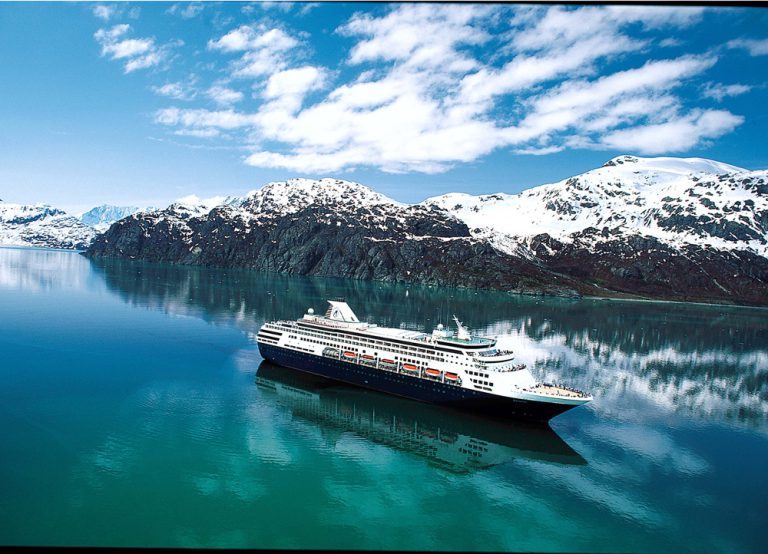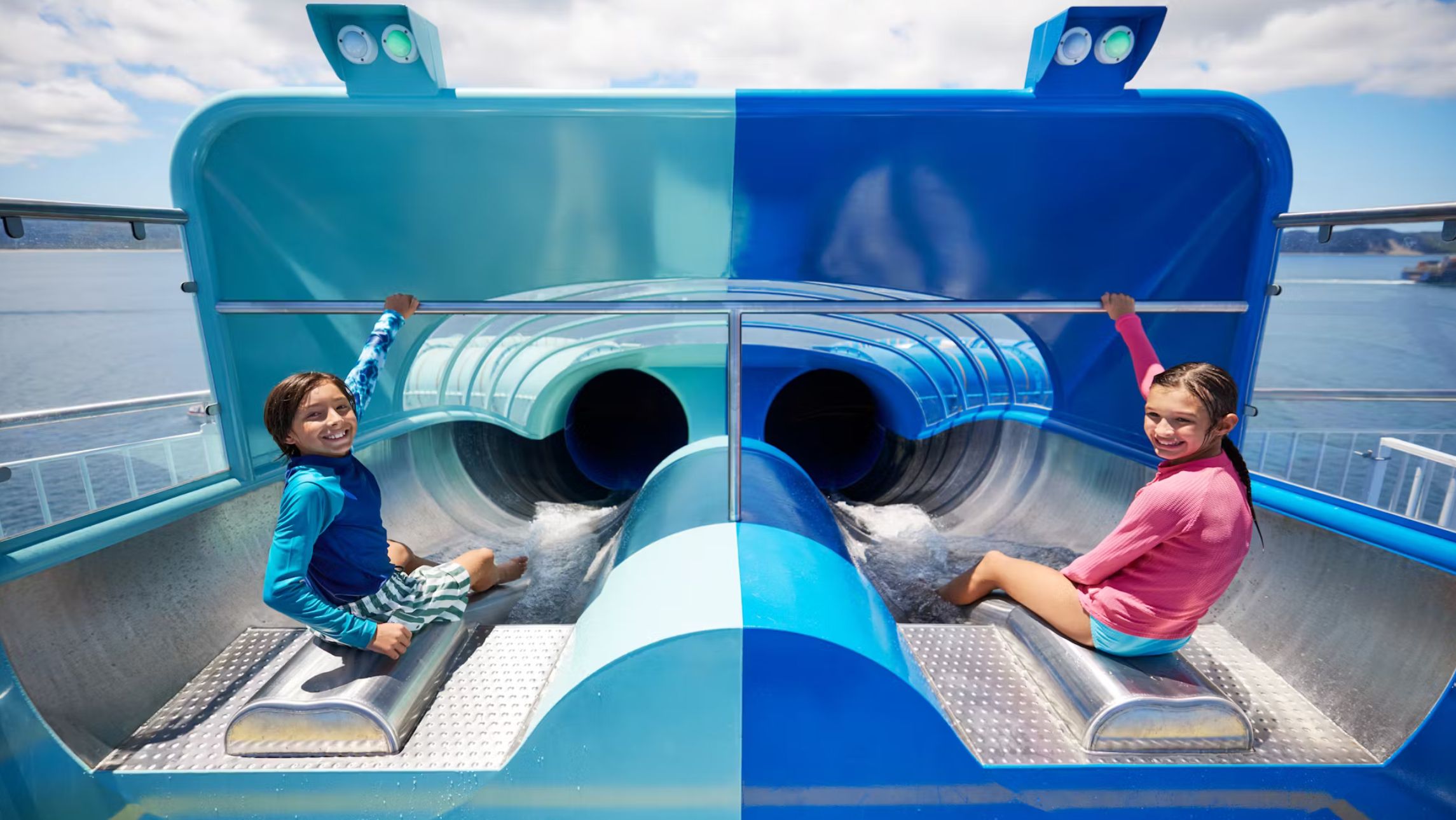It takes three flights (Sydney to LA, LA to Seattle, and Seattle to Anchorage) to get to Alaska, America’s 49th state, and because you cross the dateline you arrive on the same day you left.
We were met at the airport and taken to Alyeska Resort in Girdwood by bus (74 kilometres along the scenic Seward Highway). As my husband, Geoff, and I were the only passengers, we had uninterrupted access to driver Mary’s enthusiastic introduction to the gobsmackingly beautiful Chugach State Park – half a million acres of snow-capped mountain ranges – and Turnagain Arm. Although we tried, unsuccessfully, to spot a beluga whale in this vast waterway, we did see Dall sheep on the rocky cliffs and a bald eagle. The first of many, as it turned out.
Checking in at the resort, a large ski lodge at the base of Mount Alyeska, we realised it wasn’t going to get dark until about midnight so we took the tram to Seven Glaciers restaurant/bar at the peak. It was quite unreal. Twenty-four hours ago we were leaving dark, rainy Sydney and now we’re chatting with barman Dave the Wave and local pyrotechnics expert and engineer Lynn C. Johnson in a bar surrounded by sunlit, snowy mountains.
The following day dawned bright and extremely early – there are about 22 hours of daylight on the summer solstice and we were only a couple of days away from that. The bus ride south to the port of Seward, through the Turnagain Pass, took about an hour and a half and, once again, our driver was a font of information and family anecdotes. Alaskans are extremely proud of their state and refer to the rest of America as ‘the lower 48’. The population is just 710,000 and most people are employed in the resources industry (mining, oil and logging), military and government, and tourism.
Seward
After we’d boarded Holland America Line’s Zaandam and made a quick exploration of the ship we headed off in the local school bus to visit Seward’s Alaska SeaLife Center on the shore of Resurrection Bay. This popular exhibition features Alaskan seabirds, seals and sea lions, fish (salmon in all its varieties) and some extraordinary marine life. Particularly fascinating was the giant Pacific squid.
We wandered along the waterfront back to the ship and sampled the locally brewed beer and a seafood snack in Chinooks Bar, overlooking busy Littleboat Harbour. Later we met the rest of our party – writers and photographers from the US, Holland and Canada – and the youthful Captain Andre van Schoonhoven over drinks at the Crow’s Nest Bar. After the safety briefing we had dinner in the Rotterdam Dining Room (you couldn’t choose better than the fresh oven-baked salmon) as we pulled out of Seward
en route for the famed Glacier Bay.
Two sea days followed, during which I joined a tour of the Rotterdam Dining Room’s galley, had a facial at the Greenhouse Spa, took a yoga class and watched dolphins cavorting in the icy sea. We attended a very informative talk about Alaskan wildlife by Zaandam’s travel guide, Wallis, and learned about grizzlies and black bears, shorebirds such as the Arctic tern and black-legged kittiwake, and the marine mammals who inhabit these freezing waters. More than a million birds congregate in Alaska in the spring to undertake their annual flight down the Pacific Flyway.
Glacier Bay & Haines
We had a full day cruising around the fjords and inlets of the 65-mile Glacier Bay. By this time I had run out of adjectives – awe-inspiring, amazing, majestic, vast – for the frozen wilderness surrounding us. We spent hours on the bow gazing at icebergs and glaciers and listening to their eerie creaking, while park rangers gave a talk about the national park’s history and geology that was broadcast (quietly) inside and out.
Dinner was at the Pinnacle Grill, the only restaurant on board where you pay a supplement (US$25). The steaks and lamb chops were enormous and cooked to perfection. Sam the cellar master serves wines with just the right amount of information about them; on longer cruises you can book a Sommelier Dinner and dine with the chef.
On the day of the summer solstice the ship docked in Haines just before 6am. It was cool, grey and misty but, as we discovered, the temperature can vary enormously within a few hours. Our main mission was to visit the Steve Kroschel Wildlife Center, about 45 kilometres out of town. The morning driver, Tom, an ex-military man, showed us the golf course, which is regularly flooded by 20-foot (six-metre) tides and visited by bears and moose. He pointed out the Chilkat (‘big fish’) and Chilkoot (‘basket of many fish’) inlets and said the sockeye salmon were starting to run. Tom has a dry, laconic delivery and, like the other drivers we met, is extremely well informed and keen to educate his passengers about Alaska’s abundant natural attractions.
At the wildlife centre our small group met owner-operator Steve Kroschel, a handsome, energetic man of 51 who has worked on hundreds of wildlife films and TV shows and set up the 24-hectare centre for orphaned or injured animals in the 1980s. Steve introduced us to Mario, who had a red-tailed hawk perched on his shoulder and shares a similar wildlife-loving history as Steve – the two have been friends for 30 years.
Steve, Mario and Mr Seward, another guide, took us on a thoroughly entertaining walk through the centre, which is a series of enclosures and rambling pathways. We saw – and in
some cases patted – moose, reindeer,
Kitty the brown (grizzly) bear, ermine, weasels, porcupine, lynx and, most amazing of all, a rare wolverine that
Steve had hand-reared.
Back in Haines we wandered around the attractive waterfront and streets. Totem poles are a powerful reminder of the area’s original inhabitants and are carved by members of the Alaska Indian Arts, a group dedicated to perpetuating Tlingit culture. The town is also known for its gold rush history.
Mendenhall Glacier
The next port of call was Alaska’s capital, Juneau. As we were taking a helicopter flight to walk on Mendenhall Glacier we dressed in layers, including waterproof jackets. It was cold and rainy for a couple of hours but nothing could detract from the sheer exhilaration of the flight and walking on the glacier.
At the Temsco HQ we were fitted with specially designed boots and given a thorough safety briefing before we boarded an AStar 350 Series chopper. We had front seats next to the pilot, but wherever you sit the views are incredible and the pilot narrates the trip through headsets. The overcast sky accentuated the brilliant aquamarine blues of the crevasses and one of the many highlights of the trip was drinking pure glacial water that was hundreds of years old.
Back in the city, the sun came out and we took the tram to the peak of Mount Roberts. The views were absolutely spectacular and a short trail at the top offered an easy and rewarding walk in the crisp alpine air. We had a beer and delicious crab bisque at Tracy’s King Crab Shack, just by the docks, before boarding the ship for the next leg of the cruise to Ketchikan.
Ziplining in Bear Creek
We didn’t have a shore excursion organised but a friend had recommended ziplining in Bear Creek, near Ketchikan. As we hadn’t seen any bears in the wild we thought this might be our last opportunity to do so. We booked a tour and, while waiting for the 2pm meet-up, wandered along historical Creek Street (Ketchikan’s original red-light district) and spent a couple of hours at the fascinating Southeast Alaska Discovery Center in Main Street.
The 13-kilometre drive to the ziplining centre in the Herring Cove rainforest reserve takes you along the coast and past the Saxman Totem Park, another popular attraction (which we didn’t have time to squeeze in). At the centre we were transported up a steep hill in a Unimog, an open-sided all-terrain 4WD vehicle, to a chalet, where we were kitted out with harnesses, helmets and thick leather gloves.
I have a chronic fear of heights, but so does my friend who recommended the ziplining, so after the trial run I thought if she could do it so could I. Our group of six was in the capable hands of instructors Joe and Abbey. The first leap from a tree platform into the unknown was terrifying but exhilarating, and crossing a skybridge over a creek was reminiscent of feeling sick with fear on Northern Ireland’s Carrick-a-Rede Rope Bridge. However, getting stuck in the middle of a line, hundreds of feet above the ground, was just terrifying – without any sort of exhilaration. All I could do was breathe and focus on not looking down until Joe zipped along to rescue me. Rappelling down a vertical drop was (almost) a cinch after that.
Master Chefs International
Heading south to Vancouver, there are fewer snowy peaks and more wooded slopes, and more boats and ships pass by. It was hard to believe this was our last day. Having packed and taken a few hundred more photos, we met in the Rotterdam Dining Room for the Master Chefs International Dinner. We could choose anything from the four menus, which featured dishes from North and South America; Asia and Australia; Europe and Africa; and Chef Rudi’s ‘Tour Around the World’. In the middle of dinner Chef Rudi turned on the music and all 30 waiters marched around the dining room in the Baked Alaska Parade. It was very funny and very well done – a fitting finale to a wonderful cruise.
This review appeared in Cruise Passenger 50 and was written in 2013.








